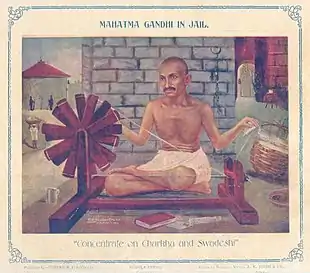Swadeshi movement
The Swadeshi movement was part of the Indian independence movement and contributed to the development of Indian nationalism.[1] The movement, begun in 1906 by Indian nationals opposed to the Partition of Bengal, was one of the most successful movements against British rule. Swadeshi was a focus of Mahatma Gandhi, who described it as the soul of swaraj (self-rule). It was the most significant movement in Bengal, and was known as the Vande Mataram movement in Andhra Pradesh. The movement ended in 1911.

The government's decision to partition Bengal was made in December 1903. The official reason was that Bengal, with a population of 78 million, was too large to be administered; the real reason, however, was that it was the center of the revolt and company officials could not control the protests which they thought would spread throughout India. Bengal was divided by language religion; the western half would be primarily Hindu, and the eastern half would be primarily Muslim. This divide-and-conquer strategy sparked the Swadeshi movement.[2]
Etymology
Swadeshi is a conjunction (sandhi) of two Sanskrit words: swa ("self" or "own") and desh ("country"). Swadeshi is an adjective which means "of one's own country".[3]
History
- 1850–1904: Dadabhai Naoroji, Gopal Krishna Gokhale, Mahadev Govind Ranade, Bal Gangadhar Tilak, G. V. Joshi, and Bhaswat K. Nigoni began organizing to promote Indian nationalism (the First Swadeshi Movement).[2]
- 1905–1917: The movement opposed the 1905 Partition of Bengal, which was ordered by Lord Curzon.[2]
- 1918–1947: The movement was further shaped by Mahatma Gandhi, leading to Indian independence from British rule.[2]
Ram Singh Kuka of the Sikh Namdhari sect[4] is also credited with developing the Swadeshi movement, since his 1871–1872 movement inspired Bengalis and other Indians to fight British rule.[5] Kuka instructed Namdharis to wear only Indian clothes and boycott foreign goods.[6] The Namdharis resolved the conflict in a people's court, bypassing British law and courts. They also boycotted the educational system, since Kuka prohibited children from attending British schools.[7]
Influence
According to a 1999 article, E. F. Schumacher (author of Small Is Beautiful) was influenced by Gandhi's concept of Swadeshi.[8] On 7 August 2015, Prime Minister Narendra Modi commemorated the first annual National Handloom Day in India to promote indigenous handloom and khadi products. The date was chosen because on 7 August 1905, the Swadeshi movement was proclaimed to avoid foreign goods and use only Indian-made products.[9] Shripad Naik, minister of state for the Ministry of AYUSH, promoted Swadeshi Shopping (a marketplace for small and medium-sized enterprises) in 2017 as part of the government's Make in India initiative. [10]
See also
- Continental Association
- Sarvodaya
- Khadi and Village Industries Commission
- National Charkha Museum
- Rajiv Dixit
- Stand-Up India
- Startup India
- Swadeshi Jagaran Manch
- Autarky – A country, state, or society that is economically independent
- Juche – The North Korean philosophy of self-reliance
- Self-determination
References
- L. M. Bhole, Essays on Gandhian Socio-Economics, Shipra Publications, Delhi, 2000. Chapter 14: "Swadeshi: Meaning and Contemporary Relevance".
- "History of Swadeshi Movement : Causes & Effects". Cultural India. 2018-07-19. Retrieved 2020-09-20.
- "Swadeshi". Metta Center. 2009-05-03. Retrieved 2020-10-01.
- Anjan, Tara; Rattan, Saldi (2016). Satguru Ram Singh and the Kuka Movement. New Delhi: Publications Division Ministry of Information & Broadcasting. ISBN 9788123022581.
- McLeod, W. H.; French, Louis (2014). Historical Dictionary of Sikhism. Rowman & Littlefield. p. 261. ISBN 9781442236011.
- Clarke, Peter (2004). Encyclopedia of New Religious Movements. Oxon: Routledge. p. 425. ISBN 9781134499700.
- Kaur, Manmohan (1985). Women in India's freedom struggle. Sterling. p. 76.
- Weber, Thomas (May 1999). "Gandhi, Deep Ecology, Peace Research and Buddhist Economics". Journal of Peace Research. 36 (3): 349–361. doi:10.1177/0022343399036003007.
- "Explained: Why is August 7 called National Handloom Day". The Indian Express. 7 August 2020.
- "Ministry of AYUSH letter". Retrieved 15 November 2020.
Further reading
- Bandyopadhyay, Sekhar. From Plassey to Partition - A History of Modern India (2004) pp 248–62
- Das, M. N. India Under Morley and Minto: Politics Behind Revolution, Revolution, and Reform (1964)
- Gonsalves, Peter. Clothing for Liberation, A Communication Analysis of Gandhi's Swadeshi Revolution, SAGE, (2010)
- Gonsalves, Peter. Khadi: Gandhi's Mega Symbol of Subversion, SAGE, (2012)
- Trivedi, Lisa. "Clothing Gandhi's Nation: Homespun and Modern India", Indiana University Press, (2007)
- Trivedi, Lisa N. (February 2003). "Visually Mapping the 'Nation': Swadeshi Politics in Nationalist India, 1920-1930". The Journal of Asian Studies. Association for Asian Studies. 62 (1): 11–41. doi:10.2307/3096134. JSTOR 3096134.
| Look up swadeshi in Wiktionary, the free dictionary. |